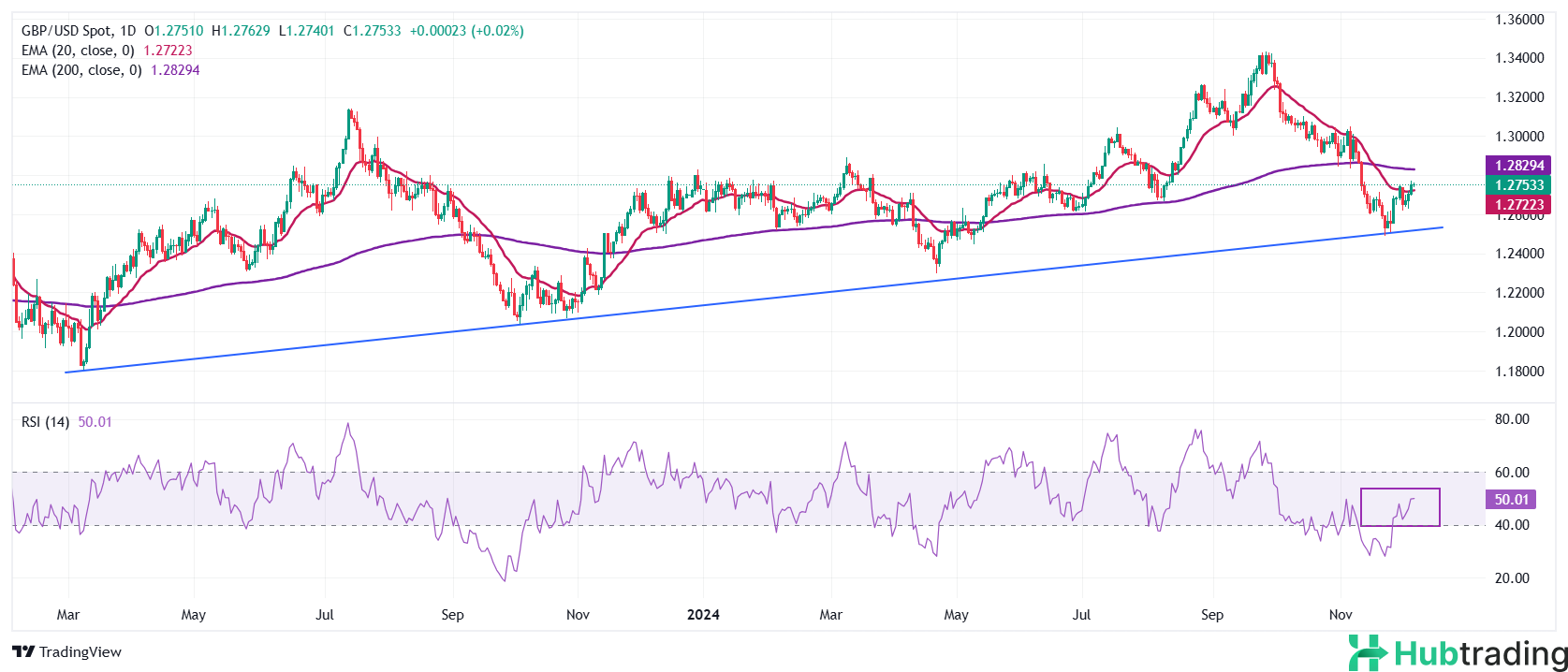- The Pound Sterling remains steady near 1.2770 against the US Dollar as markets await the release of November’s US labor market data at 13:30 GMT.
- Investors anticipate a 25 basis point rate cut by the Federal Reserve during its December 18 policy meeting.
- Bank of England policymaker Megan Greene cautioned on Thursday that UK inflation could stay above the 2% target in the medium term.
The Pound Sterling (GBP) remains steady near 1.2770 against the US Dollar (USD) during European trading on Friday. This follows a sharp rise on Thursday after the release of the US Initial Jobless Claims data for the week ending November 29, which showed an increase to 224K claimants, compared to the previous week’s 215K and market expectations.
The GBP/USD pair is expected to trade within a narrow range ahead of the US Nonfarm Payrolls (NFP) data for November, set to be released at 13:30 GMT. This data will be closely watched by investors seeking insights into whether the Federal Reserve (Fed) will cut interest rates during its December 18 policy meeting. The Fed, which initiated its policy-easing cycle in September due to concerns over weakening labor demand and confidence in inflation returning to its 2% target, remains in focus.
Economists predict the US economy added 200K new jobs in November, a rebound from October’s modest 12K increase, which was impacted by hurricanes and labor strikes at Boeing plants. The Unemployment Rate is expected to tick up slightly to 4.2% from 4.1%.
Attention will also be on the Average Hourly Earnings report, a key indicator of wage growth. Year-over-year, wages are forecast to rise by 3.9%, slightly lower than October’s 4%. Month-over-month, wage growth is projected to slow to 0.3% from the previous 0.4%.
Any signs of cooling labor demand or moderating wage growth could strengthen expectations of a dovish Fed stance, increasing the likelihood of a 25-basis-point rate cut to 4.25%-4.50%. Conversely, robust job data could challenge these expectations. According to the CME FedWatch tool, there is currently a 72% probability of a rate cut at the upcoming meeting, with the remaining 28% expecting no change.
Daily Market Movers: Pound Sterling Rises Amid Concerns of Persistent UK Inflation
- The Pound Sterling gained strength against major currencies on Friday as Bank of England (BoE) officials voiced concerns about ongoing inflationary pressures.
- Megan Greene, an external member of the BoE’s Monetary Policy Committee (MPC), warned on Thursday that UK inflation might stay above the 2% target in the medium term, describing it as “fundamentally more persistent,” according to Bloomberg.
- Greene attributed her concerns to sustained wage growth, stating, “Wage growth is not falling as quickly as I would like.”
- Similarly, on Wednesday, BoE Governor Andrew Bailey acknowledged that while the disinflation process is well underway, the central bank still has work to do to bring inflation below the 2% target.
- With no major UK economic data releases expected in the near term, market focus will shift to the BoE’s upcoming monetary policy meeting on December 19. Traders widely anticipate the central bank will maintain its current interest rate at 4.75%, influencing the Pound Sterling’s trajectory.
Technical Analysis: Pound Sterling Holds Above Key 20-Day EMA

The Pound Sterling sustains Thursday’s gains, trading near 1.2770 against the US Dollar (USD) during Friday’s London session. The GBP/USD pair remains steady above the 20-day Exponential Moving Average (EMA) at 1.2715, signaling short-term support. However, the broader trend remains bearish as the pair continues to trade below the 200-day EMA, which is positioned around 1.2825.
The 14-day Relative Strength Index (RSI) has recovered to neutral territory after dipping into oversold levels on November 22, though the downside bias persists.
On the downside, the pair is expected to find strong support near the upward-sloping trendline at 1.2500, originating from the March 2023 low of 1.1800. Conversely, the 200-day EMA serves as a critical resistance level, capping further upside potential.





